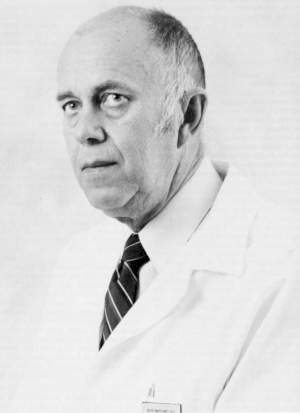
|
 |
|
{Page 67}
| Top of Page | Table of Contents | Home |

The 1985 Oklahoma Academy of Science Scientist of the Year award was presented to Dr. Ralph F. Kampschmidt at the November 15, 1985 technical meeting in Shawnee to recognize his extended meritorious service to the advancement of science in Oklahoma.
Dr. Kampschmidt received his education in Missouri culminating in a Ph.D. degree in biochemistry at the University of Missouri in 1951. His doctoral work involved the biochemistry of bull spermatozoa viability during storage. After completing his doctoral degree he spent three years as a research chemist with Armour and Company and in 1955 joined the Samuel Roberts Noble Foundation Biochemistry Division as head of the tumor section, a position he held until his retirement in 1985.
Kampschmidt's greatest accomplishments have come in the field of biochemical cancer research. His efforts as an integral part of the Noble Foundation's Biomedical Team have been directed toward answering the question "Are the systemic effects of the disease state all negative, or are some positive responses to the negative situation?"
Dr. Kampschmidt's research interest has centered on the fact that characteristic alterations occur in a host's metabolism during the acute stages of infection, inflammation, trauma, or other stress caused by diseases. In the late 1950s it was dogma that the changes occurring in cancer patients were the result of the "toxohormone" produced by the cancer. Kampschmidt proved that the effect was not directly attributable to the cancer but to a bacterial infection residing in the tumor mass. In 1962 he reported the "Absence of Toxohormone in Rat Tumors Free of Bacterial Contamination" at a cancer meeting in New Orleans. This discovery redirected much research in the area toward studies that have shown that some host responses are initiated through common mediators called "monokines".
Recently the Reticuloendothelial Society extended a lifetime membership to Dr. Kampschmidt in part for his "pioneering and continued contributions to our knowledge of leukocyte endogenous mediator/endogenous pyrogen/interleukin-1".
An international symposium dedicated to Dr. Kampschmidt convened at the University of Michigan in 1985 and concerned "The Physiological and Metabolic and Immunologic Actions of Interleukin-1". This protein, which is secreted by many white blood cells, mediates many host defense and immune responses. This special family of proteins is released from macrophages almost immediately after any type of stress on the body. Dr. Kampschmidt states "This is one of the first reactions that takes place after an insult to the body and it is the internal mediator that causes such things as fever . . . it triggers whole defensive mechanisms".
This protein was given the name IL-1 about six or eight years ago when research established that the molecule acted as a helper in immune reactions. The central contribution of Dr. Kampschmidt and his group at the Noble Foundation was in showing the "effects of a molecule called LEM (leukocytic endogenous mediator) was the same protein that caused fever ... it was also a factor in immune reactions."
Dr. Kampschmidt has written numerous reviews and published chapters in six books just since 1980. The results of his research have appeared in well over eighty research articles.
He has also been dedicated to the community of Ardmore, Oklahoma where he has served as a member of the Board of Directors and past President of the Kiwanis Club, the YMCA, the Carter County Chapter of the American Cancer Society, has been on the Administrative Board and acted as chairman and a trustee of the United Methodist Church, and has been on the advancement committee of the Boy Scouts of America.